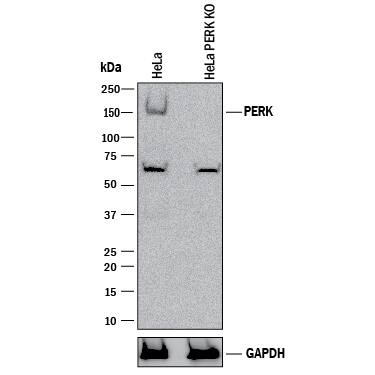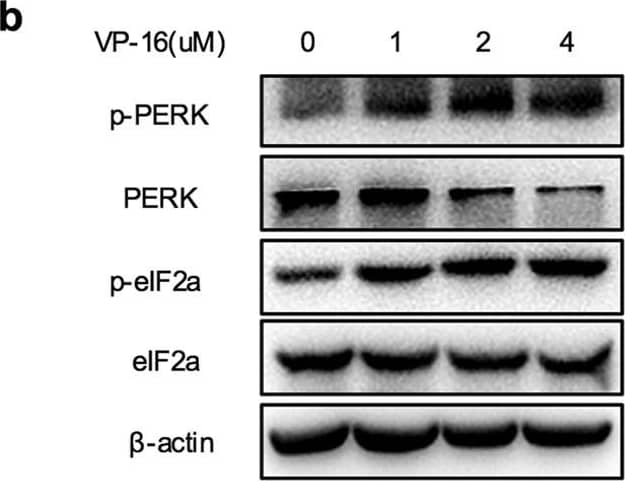Human PERK Antibody
R&D Systems, part of Bio-Techne | Catalog # AF3999

Key Product Details
Validated by
Species Reactivity
Validated:
Cited:
Applications
Validated:
Cited:
Label
Antibody Source
Product Specifications
Immunogen
Ala29-Gln230
Accession # Q9NZJ5
Specificity
Clonality
Host
Isotype
Scientific Data Images for Human PERK Antibody
Detection of Human PERK by Western Blot.
Western blot shows lysates of HepG2 human hepatocellular carcinoma cell line and NTera-2 human testicular embryonic carcinoma cell line. PVDF membrane was probed with 1 µg/mL of Human PERK Antigen Affinity-purified Polyclonal Antibody (Catalog # AF3999) followed by HRP-conjugated Anti-Goat IgG Secondary Antibody (Catalog # HAF017). A specific band was detected for PERK at approximately 130 kDa (as indicated). This experiment was conducted using Immunoblot Buffer Group 1.Western Blot Shows Human PERK Specificity by Using Knockout Cell Line.
Western blot shows lysates of HeLa human cervical epithelial carcinoma parental cell line and PERK knockout HeLa cell line (KO). PVDF membrane was probed with 1 µg/mL of Goat Anti-Human PERK Antigen Affinity-purified Polyclonal Antibody (Catalog # AF3999) followed by HRP-conjugated Anti-Goat IgG Secondary Antibody (Catalog # HAF017). A specific band was detected for PERK at approximately 150 kDa (as indicated) in the parental HeLa cell line, but is not detectable in knockout HeLa cell line. GAPDH (Catalog # AF5718) is shown as a loading control. This experiment was conducted under reducing conditions and using Immunoblot Buffer Group 1.Detection of Human PERK by Western Blot
Activation of the ER stress signaling pathway leads to the LX-2 cell apoptosis induced by VP-16.(a) Western blotting analysis of ER stress-associated proteins in LX-2 cells after treatment with VP-16 for 72 h. (b) After exposure to VP-16 for 72 h, the protein phosphorylation levels of PERK and eIF2 alpha were analyzed by western blotting. (c) After exposure to VP-16 for 72 h, the proteins of the IRE1 alpha /ASK1/JNK signaling pathway were analyzed by western blotting. (d,e) LX-2 cells were pretreated with a JNK inhibitor (SP600125, 40 μM) for 1 h, and then treated with 4 μM VP-16 for 72 h. (d) Cell viability was measured using the CCK-8 assay. The percentage of apoptosis cells was analyzed by flow cytometry. The data are presented as the mean ± SD of at least three independent experiments performed in triplicates. **P < 0.01, compared with the group treated with VP-16 alone. (e) Western blotting analysis of the cell lysates was performed using the indicated antibodies. In all of the western blotting analyses, beta-actin was used as a loading control. *P < 0.05, compared with the control group. #P < 0.05, compared with the group treated with VP-16 alone. Image collected and cropped by CiteAb from the following publication (https://pubmed.ncbi.nlm.nih.gov/27680712), licensed under a CC-BY license. Not internally tested by R&D Systems.Applications for Human PERK Antibody
Knockout Validated
Western Blot
Sample: HepG2 human hepatocellular carcinoma cell line and NTera-2 human testicular embryonic carcinoma cell line
Reviewed Applications
Read 1 review rated 5 using AF3999 in the following applications:
Formulation, Preparation, and Storage
Purification
Reconstitution
Formulation
Shipping
Stability & Storage
- 12 months from date of receipt, -20 to -70 °C as supplied.
- 1 month, 2 to 8 °C under sterile conditions after reconstitution.
- 6 months, -20 to -70 °C under sterile conditions after reconstitution.
Background: PERK
PERK, a type 1 ER membrane kinase, mediates eIF2 alpha phosphorylation at Ser51 during the UPR (unfolded protein response). Protein synthesis is inhibited, thereby reducing the burden of protein substrate for the ER folding and degradation mechanism. Phosphorylation of eIF2 alpha also selectively promotes the expression of UPR target genes such as Chop and BiP. PERK may also play a role in tumor cell adaptation to hypoxic stress by regulating the translation of angiogenic factors necessary for the development of functional microvessels. Mutations in PERK are responsible for the rare autosomal-recessive disorder, WRS (Wolcott-Rallison syndrome).
Long Name
Alternate Names
Gene Symbol
UniProt
Additional PERK Products
Product Documents for Human PERK Antibody
Product Specific Notices for Human PERK Antibody
For research use only


